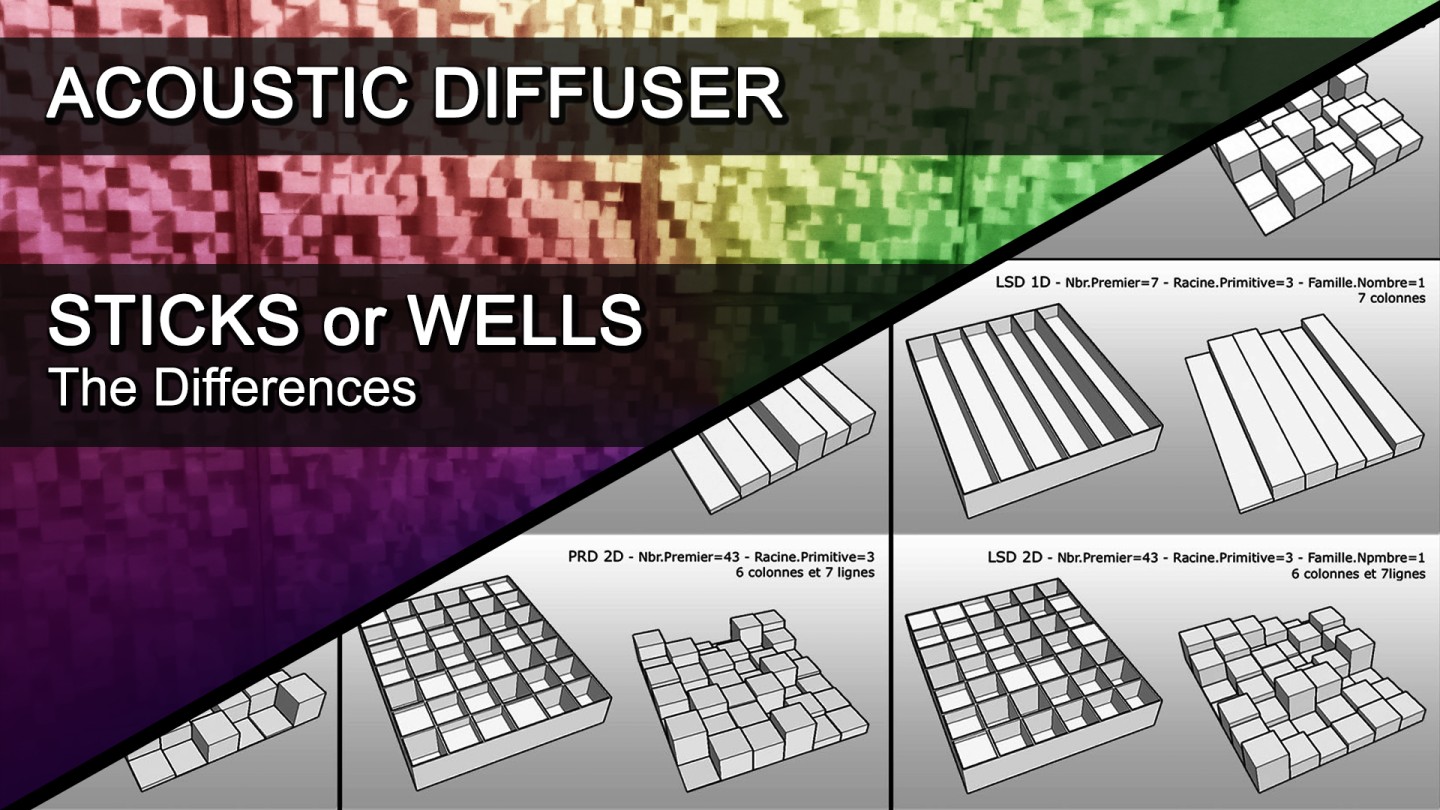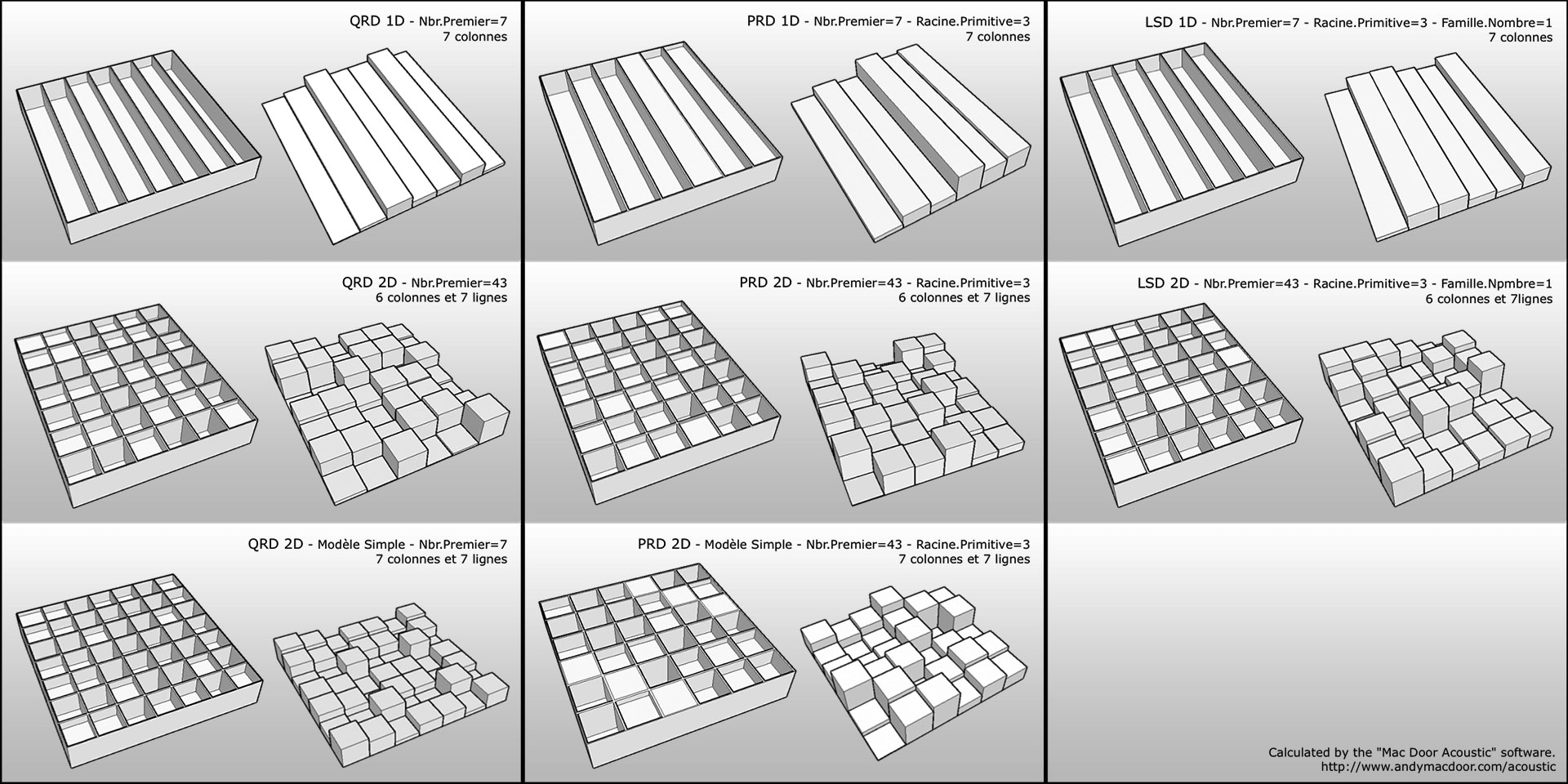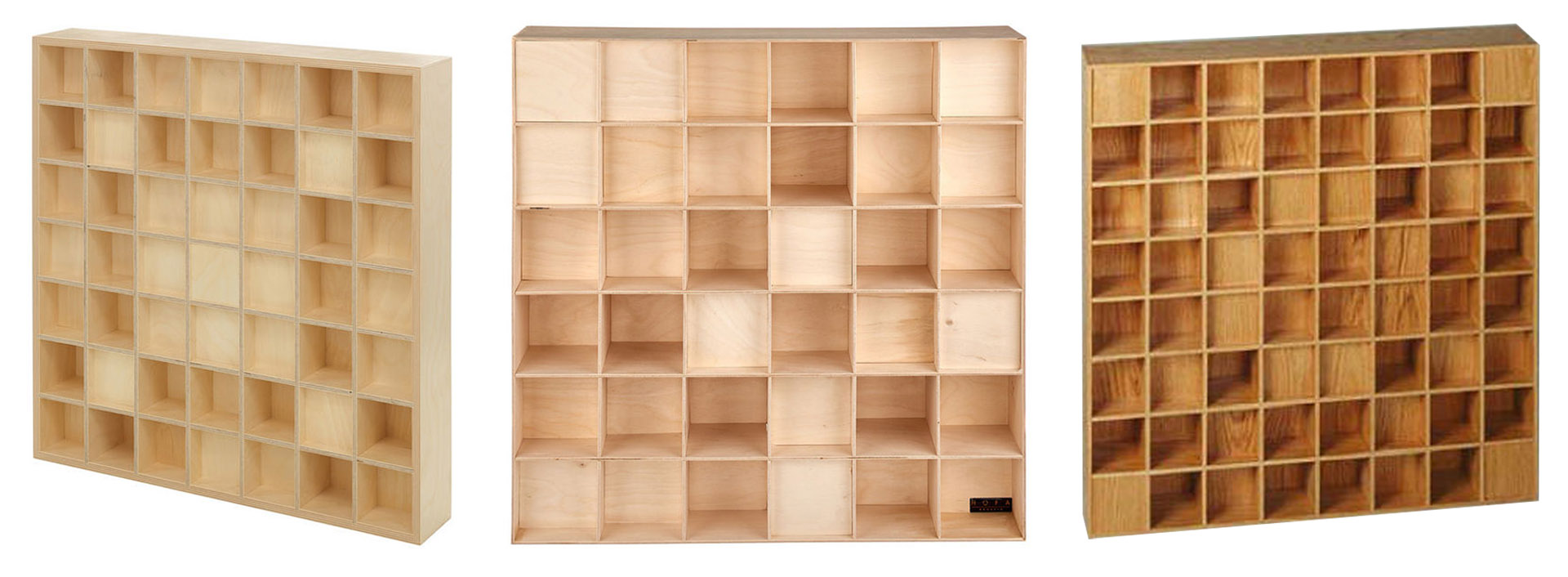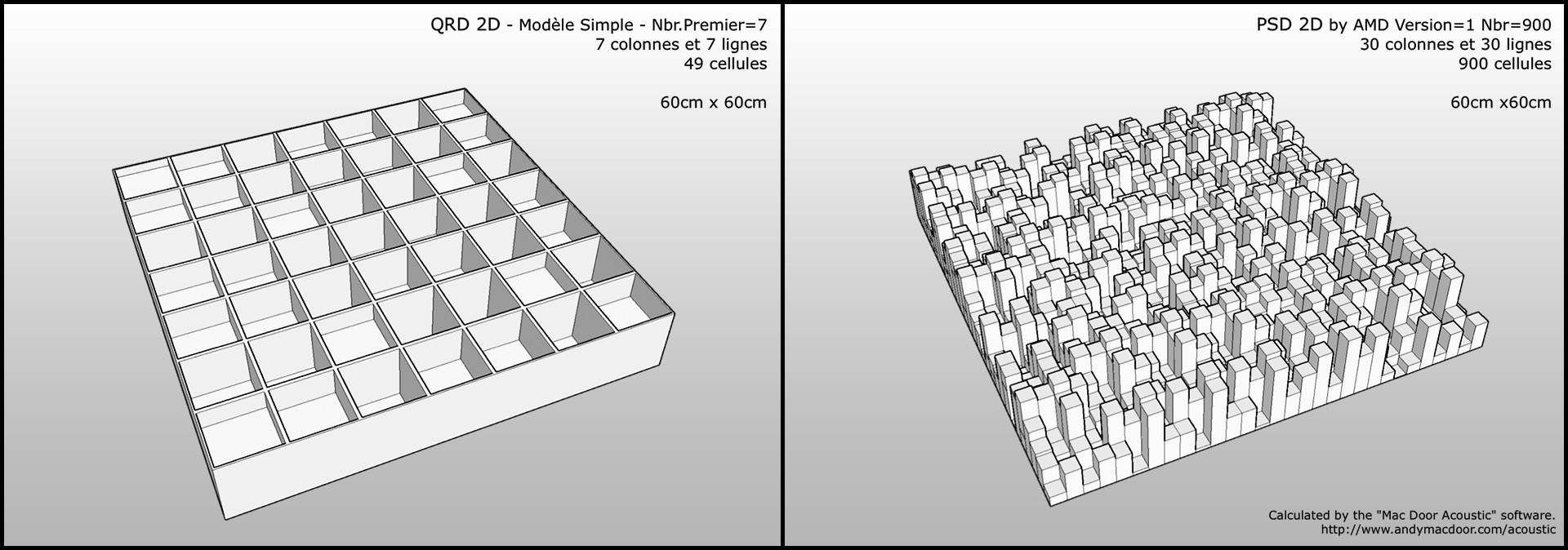



When it comes to diffusers, "experts" generally agree on a preference for well-based designs over stick-based ones. However, my investigations have led me to the conclusion that, depending on the sequence type and implementation constraints, stick-based designs often yield better results when the number of cells is substantial. After selecting the diffusers (generated randomly using the "Mersenne Twister") that exhibit superior characteristics to QRD, PRD, LSD, and PWRD models, in line with the predictions of my analyzer using the "brute force" method, I set out to examine the similarities in their designs to identify the elements necessary for optimal diffusion.
Regarding diffusers, "experts" generally agree on a preference for well-based designs over stick-based ones. However, my investigations have led me to the conclusion that, depending on the sequence type and implementation constraints, stick-based designs often yield better results when the number of cells is significant.
After selecting diffusers (generated randomly using the "Mersenne Twister") that demonstrate superior characteristics to QRD, PRD, LSD, and PWRD models, in line with predictions from my brute-force analyzer method, I set out to examine similarities in their designs to identify the elements necessary for optimal diffusion.
I initially undertook this task by studying diffusers made up of real well-based cells, and then comparing them to their counterparts composed of "pseudo-stick" cells. Unexpectedly, the top ten diffusers using real well-based cells were displaced from the top twenty when based on "pseudo-stick" cells.
In this context, the aim of this presentation is not to detail the numerous raw analyses of my study but rather to pedagogically demonstrate the factors I consider crucial in the design of the optimal diffuser.

The most challenging issue I mentioned in the previous chapter undoubtedly concerns the fact that well-based designs (cells) are complex to construct, as they require building walls to accommodate a well's bottom.
Furthermore, it should be noted that the walls must be as thin as possible to limit the amplitude of specular reflection that occurs on exposed surfaces.
Therefore, although the design of well-based cells is undeniably optimal from a theoretical perspective, replacing them with simple sticks greatly simplifies the structure's realization and thus offers the opportunity to significantly increase the number of "pseudo" cells.


Practically, when observing the market in 2020, the best well-based diffuser consists of about 50 wells for a 60cm by 60cm structure. In contrast, for the same dimensions, the best stick-based diffuser (created by your esteemed author) consists of 900 "pseudo" cells.
As a result, while the theoretical efficiency (noting it's "theoretical") of temporal-plane diffusion of a "pseudo" cell created by sticks is much lower than a design with real cells surrounded by walls to form wells, the stick-based design simply "bypasses" this inferiority by significantly increasing the number of sticks and thus "pseudo" cells.
In this example, the stick-based design has 18 times more "pseudo" cells than the well-based diffuser. Furthermore, the width and thickness of these sticks are four times smaller than the width of the cells of the well-based diffuser (in this example), allowing the stick-based diffuser to act over a much wider frequency range in the treble and in a much more homogeneous temporal manner (linear energy decay).
Additionally, stick-based designs generally have the advantage of suffering less from phase correlations that occur when two or more waves reflected by wells interfere.
This reduction in phase correlations compared to well-based diffusers is manifested by the "pseudo-wells" that are created between several sticks. Since these "pseudo-wells" come in various shapes and sizes, unlike the well-based diffuser with exactly the same shapes, the energy lobes reflected are almost all different from each other, thus having less "chance" of being correlated.
However, the sequence plays an absolutely crucial role in this regard. And since it is much simpler to predict phase correlations with a model with cells of the same shape like those in well-based models, it is wrongly assumed that they are just as effective for stick-based models, which my BEM simulations have perfectly demonstrated.
In this "wave tank" simulation (visible in the animation above), you can observe the scattering and energy decay phenomenon of a sound wave incident at 0° (direct) when it encounters different diffuser designs.
The first column titled "RS" (Specular Reflection) serves as a reference point by showing the specular reflection that occurs with a massive object of the same size, allowing for comparison with the diffusers in the other columns.
From these examples, it can be observed that stick-based models exhibit a slightly more uniform diffusion pattern than well-based designs. This suggests that the comb filter effect (characterized by noticeable peaks and nulls at the listening point) will be less pronounced with stick-based diffusers compared to well-based diffusers.
To better appreciate this difference, it is advised to pause the animation and observe how the "smoothing" results in a slightly blurred "image."
In the simulation displayed above, we observe a sound wave incident at a 45° angle relative to the diffuser.
While the "smoothing" phenomenon is slightly more pronounced with stick-based diffusers, which presents an advantage, stick-based designs, however, face more difficulty in capturing energy from the front of the sound wave that grazes the diffuser (pause at the eleventh second).
The animations presented above and below are, in fact, a segmentation of the previous animations, aiming to highlight the sound wave's energy storage capability when it reaches the diffuser.
In terms of this aspect, it is undeniable that well-based diffusers have a significantly higher capacity than stick-based designs. In this context, well-based diffusers exhibit a capacity nearly three times greater than that of stick-based designs.
Therefore, true well-based diffusers result in a significantly longer energy decay than stick-based designs. Thus, it is reasonable to assume that to achieve similar results, the cells (sticks) in stick-based diffusers should be approximately three times narrower than those in well-based designs. However, this assumption depends once again on the sequence, as to realize it, the height difference between the sticks must be significant enough to generate an adequate "pseudo-well."
However, one can question the relevance of opting for a more extended decay while sacrificing a smoother decay. Especially given that the acoustic treatment of dedicated listening spaces involves, in most situations, reducing reverb and the influence of specular reflections. From this perspective, stick-based diffusers seem much more suitable.
In conclusion, it is noteworthy that stick-based designs result in slightly less pronounced (smoother) reflections compared to those from well-based designs, which is an advantage.
In a temporal context, well-based designs far outperform their counterparts, resulting in a much longer energy decay.
However, one can question the relevance of opting for a more extended decay while sacrificing a smoother decay. Especially given that the acoustic treatment of dedicated listening spaces involves, in most situations, reducing reverb and the influence of specular reflections. From this perspective, stick-based diffusers seem more suitable.
Furthermore, it should be noted that popular sequences like QRD and PRD are not inherently optimized for stick-based designs. Therefore, it is necessary to design a dedicated sequence that highlights the energy lobe smoothing potential inherent in stick-based designs, favoring alternation between small and large cell heights.
Stick-based design ultimately possesses all the advantages one desires for the treatment of dedicated listening spaces, especially since its implementation allows for easy multiplication of cell numbers compared to well-based designs.
2 other products in the same category:
Acoustic Diffuser MDD-400-16
100.00 €equivalent to a cost price of 27.50 € per diffuser
Pair of acoustic diffusers consisting of one type A diffuser and its inverse type B. These two types are mutually mirrored with respect to each other, in order to avoid problematic phase correlations that occur when two identical elements are placed in proximity.
Each diffuser is composed of 20 pre-cut lines, to be assembled by placing them next to each other.
View this product
Authorized access
DIFFUSER - The quest for the best acoustic diffuser, pioneers and studies
3 years of research, over 6,000 hours of study, experimentation, questioning of what has already been done in terms of diffusion, and the creation of about sixty diffuser devices made with different materials and sequences in order to understand, find, and achieve the best acoustic diffusers, have led me to develop my own method for simulating the behavior of a diffuser, a demonstration method based on observing a 'ripple tank,' a serious questioning of the certainties we had about their behaviors, and finally, my own distribution method, which varies depending on whether the diffuser design is based on rods or wells.
View this tutorial
Reviews (0) - Review moderation